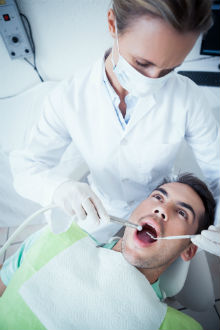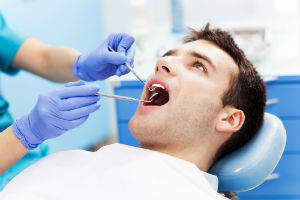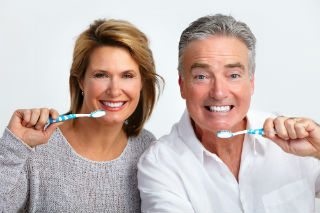Call: (203) 758-2116
Preventative Treatments
Desensitizing Treatments

Think of your gums and the enamel on your teeth as a down comforter covering and protecting your body from the cool winter air. Over time, the gums may recede or the enamel or dentin on your teeth may wear down, creating the conditions for tooth sensitivity.
We can easily identify the causes of tooth sensitivity. In fact, the causes can be as simple as the following:
- Improper brushing — brushing too hard!
- Tooth whitening
- Dental treatments, incl. simple cleanings, orthodontics, or restoration
- Natural wear and tear, i.e. enamel gone, dentin exposed
- Loss of enamel, resulting from highly acidic diets (tomatoes, soda, etc).
There are many other causes, some of which can require a more comprehensive treatment plan. To name a few:
- Broken, chipped, or fractured teeth
- Nerve damage in the root requiring a root canal
- Grinding and/or clenching the teeth which can be relieved with an oral appliance, i.e. mouthguard
- Periodontal (gum) disease which can often be relieved with a comprehensive oral hygiene regimen
- Receding gums caused by periodontal disease and/or oral habits
Desensitizers come in many forms, from simple at-home remedies to in-office solutions applied by one of our hygienists.
For mild cases where patients complain of low-level hot, cold, sweet, or sour sensitivity, many people do well using desensitizing toothpaste. Toothpastes for sensitive teeth must be used daily for the most effective results. In addition to these toothpastes, other desensitizing products include over-the-counter rinses and gels. Many over-the-counter desensitizing products offer a variety of flavors and additional benefits, such as tartar control and fluoride for cavity prevention. So ask us what product is best for you.
For very sensitive teeth, an in-office clinical desensitizer can be used first to knock down the sensitivity, and a desensitizing toothpaste can be used for ongoing maintenance.
In-office desensitizers can be painted or sprayed on while you are in our office. They can last a week, several months, or, in some cases, it’s all the patient ever needs.
In-office desensitizing is quick and painless. The desensitizer is allowed to dry on the teeth and, just like that, the patient has a new protective shield against sensitivity.
The worst thing you can do is nothing at all. In fact, failing to address sensitive teeth can cause other oral problems down the road. Sensitive teeth are easily treatable and usually involve a pain-free solution. Call us for an appointment at 203-758-2116.
Fluoride Treatments

Many dentists agree that the best way to prevent tooth decay is to use several sources of fluoride, including professional fluoride applications in our office, and prescription fluoride tablets for those children who do not get fluoride in their water.
How does fluoride help my teeth?
The visible part of your natural tooth is called the crown. The outer layer of the crown of your tooth is called enamel and is made of closely packed mineral crystals. The tooth enamel loses minerals (demineralization) and gains minerals (remineralization) every day. These two processes typically balance each other.
The type of bacteria that causes plaque on your teeth feeds on sugar in your mouth and produces acids. The acids dissolve the mineral crystals in your teeth and start demineralization. The remineralization process builds the enamel back up, meaning that minerals such as fluoride, calcium and phosphate are deposited inside the enamel.
Tooth decay occurs when there is too much mineral loss and not enough repair.
Fluoride strengthens teeth by helping to speed remineralization. Fluoride also makes teeth more resistant to dissolving bacterial acids. Your teeth can absorb fluoride in two ways, internally and externally. Internal absorption occurs when children absorb small doses from the food that they eat, as well as water that they drink and supplements that they may take. When ingested, fluoride enters the bloodstream and becomes part of the permanent teeth as they develop. This strengthens the teeth and makes it harder for the acids to destroy the enamel.
Fluoride can also enter your teeth from the surface in a number of ways including:
- Fluoride treatments applied by one of our hygienists in our office
- Brushing with fluoride toothpaste and/or using a fluoride rinse
- Fluoridated water washes over your teeth when you drink
Fluoride treatments are routinely given to children as their teeth are developing. Your child should use additional fluoride if he or she has a history of cavities or is at high risk for decay. Many children get fluoride treatments every six months. These treatments provide additional protection against cavities, even if your child already drinks fluorinated water.
If your child is over the age of 6 and has a history of cavities or is at a high risk for decay, fluoride mouth rinses can help with remineralization. You can find these rinses in the mouthwash section of most stores. Our doctors may also prescribe fluoride rinses and gels which provide a higher level of fluoride than the over-the-counter rinses.
For children between the ages of 6 months to 16 years who have well water at home or who don’t drink fluorinated water, fluoride supplements may be prescribed by our doctors or your pediatrician. These supplements are available as liquids for younger children and tablets for older children.
Fluoride treatments help all teeth and prevent decay in children as well as adults. You may be at increased risk of tooth decay considering the following factors:
- Infrequent visits to the dentist/hygienist
- Poor brushing/flossing habits
- History of cavities
- Poor diet
- Frequent snacking
- Radiation therapy
- Certain side effects from drugs
Many over-the-counter and prescription drugs can cause your mouth to be dry; they include antihistamines and medications that treat high blood pressure, anxiety and depression. Without sufficient saliva in your mouth, tooth decay worsens.
How is the fluoride applied?
Fluoride treatments are used for both children and adults. Fluoride treatments provided in our office contain more fluoride than over-the-counter products, including toothpaste and rinses. They are also different chemically and stay on your teeth longer.
We use two types of fluoride in our office: acidulated phosphate fluoride and neutral sodium fluoride. Neutral sodium fluoride is used for people who have dry mouth (xerostomia), tooth- colored (composite) fillings, crowns or bridges. APF is acidic and may irritate a mouth that is dry, and it can create small pits in composite fillings.
Please brush and floss your teeth thoroughly before your appointment.
Fluoride can be applied as a gel, foam or varnish. It can be painted directly on the teeth or it can be applied using a tray, much like a mouth guard, for 1-4 minutes. Our hygienist will first dry the teeth so that the fluoride is not diluted. Although fluoride comes in various flavors, it should never be swallowed!
Don’t eat, drink or smoke for at least 30 minutes after your in-office fluoride treatment.
This helps to increase the fluoride’s contact with the teeth.
Are there any risks?
When used properly, fluoride is safe and effective.
Everyone should use fluorinated toothpaste. Be aware that young children are more likely to swallow toothpaste than to spit it out, especially when they are flavored. Use only a pea-sized amount of toothpaste to brush their teeth with and encourage them to spit out as much as possible.
Prescription fluoride supplements are usually given to children. They are taken in small quantities and are based on the child’s age and the amount of fluoride in the water that he or she drinks. If you have any questions regarding fluoride treatments, please talk to our hygienists, our doctors or your pediatrician.
High doses of fluoride can be harmful. We do not recommend fluoride supplements for patients that drink fluorinated water. Young children, in particular, should be supervised during in-office treatments and when using fluoride products at home. Toxic fluoride doses are based on body weight. For example, a toxic dose of fluoride for an 8-year old child weighing 45 pounds is 655 milligrams (mg). In comparison, an 8-ounce glass of water with 1 part per million (ppm) of fluoride contains 0.25 mg of fluoride. A small amount of toothpaste contains 0.24 mg of fluoride. These fluoride containing products are used in such small amounts that it is very difficult to receive toxic doses in a home setting.
Young children should be supervised when using fluoride treatments at home. If they swallow too much fluoride they may become nauseous. Too much fluoride can also cause spots to form on the enamel of any developing teeth. The spots will be visible as they come into the mouth.
Our hygienists and our doctors can answer any questions or concerns you may have regarding fluoride use. We will gladly discuss what fluoride treatments are appropriate for you or your child.
Oral Cancer Screenings

Anyone can get oral cancer, which includes cancer of the throat, lips, mouth, tongue, gums and salivary glands. Although smoking increases the risk of oral cancer, more than 25 percent of oral cancer cases occur in people who never smoked.
The best way to catch oral cancer early is to have regular exams by Dr. Smith and Dr. Mandava and to learn how to check yourself.
Symptoms of Oral Cancer
Any unusual sore, spot, patch or lump that does not go away in two weeks should be checked by your dentist. Here are some symptoms of oral cancer:
- A lump or swelling in your neck or under your jaw
- Red or white patches or ulcers that do not heal in two weeks
- A lump or overgrowth of tissue anywhere in your mouth
- Pain when you chew
- Difficulty swallowing
- A hoarse voice or sore throat that doesn’t go away
- Numbness in your face or tongue
- A change in the color or size of a mole or freckle on your face
- A change in the way your teeth fit together (your bite)
Another Reason to Quit Smoking
Tobacco’s greatest threat to your health may be its link to oral cancer. The American Cancer Society reports that:
- About 90% of people with mouth cancer and some types of throat cancer have used tobacco. The risk of developing these cancers increases as people smoke or chew more or for a longer time.
- Smokers are six times more likely than nonsmokers to develop these cancers.
- About 37% of patients who continue to smoke after cancer treatment will develop second cancers of the mouth, throat or larynx. This compares with only 6% of those who stop smoking.
- Tobacco smoke from cigarettes, cigars or pipes can cause cancers anywhere in the mouth or the part of the throat just behind the mouth. It also can cause cancers of the larynx, lungs, esophagus, kidneys, bladder and several other organs. Pipe smoking also can cause cancer in the area of the lips that contacts the pipe stem.
- Smokeless tobacco has been linked to cancers of the cheek, gums and inner surface of the lips. Smokeless tobacco increases the risk of these cancers by nearly 50 times.
Oral CDx Brush Test & Diagnosis
The brush test is a quick and painless method that Dr. Smith and Dr. Mandava may use to test the common small white and red oral spots that most people have in their mouth at one time or another. The brush test is used to determine if a common oral spot contains abnormal cells (known as dysplasia) that, if left alone for several years, may develop into oral cancer.
The use of the Oral CDx BrushTest by over 30,000 U.S. dentists has resulted in the detection of over 10,000 precancerous spots – years before they could cause any harm – years before they could turn into a problem.
How we can help stop oral cancer, years before it can even start:
Our doctors can now painlessly help diagnose a disease that kills as many Americans as melanoma and twice as many as cervical cancer, and is rising among women, young people, and non-smokers. Over 25% of oral cancer victims do not use tobacco or abuse alcohol.
It typically takes several years before a dysplastic oral spot can turn into an oral cancer, and during this time, the spot can be removed and oral cancer can potentially be prevented from even starting. Just like the Pap smear is used to detect precancerous cells to help prevent cervical cancer, and colonoscopy is used to detect precancerous polyps to help prevent colon cancer, the brush test is used to detect precancerous cells in common oral spots to help prevent oral cancer. The good news is that oral cancer has now joined the short list of cancers that can be stopped years before they can even start.
What is the Brush Test?
The brush test consists of 2 components:
- A specially designed brush that a dentist uses to painlessly obtain a sample of an oral spot. The brush test requires no anesthesia, causes no pain and minimal or no bleeding.
- The analysis of that sample takes place at a specialized laboratory where specially-trained pathologists use highly sophisticated computers to help detect abnormal cells. A complete report is faxed to us as soon as the test results are available. We will call immediately after we receive the report to inform you about the findings, and if necessary discuss additional treatment options.
When is a CDx Brush Test used?
The brush test is used to test the common, harmless-appearing, small white and red spots that dentists and dental hygienists see several times each week, to determine if they contain precancerous cells. Most people will have a small oral spot like this at one time or another and they can be seen in up to 10% of carefully examined adults.
Is the Brush Test Accurate?
The brush Test is very accurate as confirmed in many published clinical studies. It has been used by over 30,000 U.S. dentists, and more than 10,000 precancerous spots have been detected with the brush test – long before they could cause any harm – long before they could turn into cancer.
Why a common oral spot can be a blessing in disguise
Most people will have tiny white or red spots in their mouth at one time or another. Although most of these spots are harmless, only laboratory testing like the brush test can determine which of them contain abnormal cells. About 96% of small, harmless-appearing oral spots that are evaluated by the brush test will not contain any abnormal cells. If precancerous cells are found in an oral spot, it typically takes several years before they can cause any harm. During this time, the spot can usually be easily and completely removed.
Oral Hygiene Education

Adults over 35 lose more teeth to gum disease (periodontal disease) than from cavities. Three out of four adults are affected at some time in their life. Regular daily tooth brushing and flossing techniques are the best way to prevent cavities and periodontal disease.
Periodontal disease and decay are both caused by bacterial plaque. Plaque is a colorless film that sticks to your teeth at the gum line. Plaque constantly forms on your teeth. By thorough daily brushing and flossing, you can remove these germs and help prevent periodontal disease.
How To Brush
Position the brush at a 45-degree angle where your gums and teeth meet, and start brushing the outside surfaces of your teeth. Gently move the brush in a circular motion several times using small, gentle strokes. Use light pressure while putting the bristles between the teeth, but not so much pressure that you feel any discomfort.
When you are done cleaning the outside surfaces of all your teeth, follow the same directions while cleaning the inside of the back teeth.
To clean the inside surfaces of the upper and lower front teeth, hold the brush vertically. Make several gentle back-and-forth strokes over each tooth. Don’t forget to gently brush the surrounding gum tissue.
Next you will clean the biting surfaces of your teeth by using short, gentle strokes. Change the position of the brush as often as necessary to reach and clean all surfaces. Try to watch yourself in the mirror to make sure you clean each surface. After you are done, rinse vigorously to remove any plaque you might have loosened while brushing.
If you have any pain while brushing or have any questions about how to brush properly, please be sure to call the office. In total, the average person should brush between 2 ½ -3 minutes.
How To Floss
Periodontal disease usually appears between the teeth where your toothbrush cannot reach. Flossing is a very effective way to remove plaque from those surfaces. However, it is important to develop the proper technique. The following instructions will help you, but remember it takes time and practice. These instructions make it easier:
Start with a piece of floss (waxed is easier) about 18″ long. Lightly wrap most of the floss around the middle finger of one hand. Wrap the rest of the floss around the middle finger of the other hand.
To clean the upper teeth, hold the floss tightly between the thumb and forefinger of each hand. Gently insert the floss tightly between the teeth using a back-and-forth motion. Do not force the floss or try to snap it in to place. Bring the floss to the gum line then curve it into a C-shape against one tooth. Slide it into the space between the gum and the tooth until you feel light resistance. Move the floss up and down on the side of one tooth. Remember there are two tooth surfaces that need to be cleaned in each space. Continue to floss each side of all the upper teeth. Be careful not to cut the gum tissue between the teeth. As the floss becomes soiled, turn from one finger to the other to get a fresh section.
To clean between the bottom teeth, guide the floss using the forefinger of both hands. Do not forget the backside of the last tooth on both sides, upper and lower.
When you are done, rinse vigorously with water to remove plaque and food particles. Do not be alarmed if during the first week of flossing your gums bleed or are a little sore. If your gums hurt while flossing you could be doing it too hard or pinching the gum. As you floss daily and remove the plaque, your gums will heal and the bleeding should stop.
Caring For Sensitive Teeth
Sometimes after dental treatment, teeth are sensitive to hot and cold. This should not last long, provided your mouth is kept clean. If your mouth is not kept clean, the sensitivity will remain and could become more severe. If your teeth are especially sensitive, consult with your doctor. They may recommend a medicated toothpaste or mouth rinse made especially for sensitive teeth.
Choosing Oral Hygiene Products
There are many products on the market which can be confusing and make choosing between them difficult. Here are some suggestions for choosing dental care products that will work for most patients.
Automatic and high-tech electronic toothbrushes are safe and effective for the majority of patients. Oral irrigators (water spraying devices) will rinse your mouth thoroughly, but will not remove plaque. You need to brush and floss in conjunction with the irrigator. We see excellent results with electric toothbrushes and recommend Triumph by Oral B.
Some toothbrushes have a rubber tip on the handle; this is used to massage the gums after brushing. There are also tiny brushes (interproximal toothbrushes) that clean between your teeth. If these are used improperly you could injure the gums, so be sure discuss proper use of these brushes with the hygienist.
If used in conjunction with brushing and flossing, fluoride toothpastes and mouth rinses can reduce tooth decay as much as 40 percent. Remember, these rinses are not recommended for children under six years of age. Tartar control toothpastes will reduce tartar above the gum line, but gum disease starts below the gum line so these products have not been proven to reduce the early stage of gum disease.
Anti-plaque rinses, approved by the American Dental Association, contain agents that may help bring early gum disease under control. Use these in conjunction with brushing and flossing.
Nutrition
Good nutrition plays a large role in your dental health. Brushing and flossing help keep your teeth and gums healthy and strong. However, a balanced diet will help to boost your body’s immune system, leaving you less vulnerable to oral disease.
What you eat and how frequently you eat it affect your dental health. Eating starchy foods cause the bacteria in your mouth to feed on it. They then produce acids, which attack your teeth for up to 20 minutes or more. Foods that stick to your teeth or are slow to dissolve give the acids more time to work on destroying tooth enamel.
Starchy foods:
- Crackers
- Breads
- Cookies
- Candy
Sticky/slow to dissolve foods:
- Granola bars
- Chewy fruit snacks
- Dried fruit
- Hard candy
Sticky and starchy foods create less acid when eaten as part of a meal. Saliva production increases at mealtime, rinsing away food particles, and neutralizing harmful acids.
Foods such as nuts, cheese, onions, and some teas have been shown to slow growth of decay causing bacteria in the mouth.
Protective Sealants
Sealants are highly effective in preventing decay on the biting surfaces of your chewing teeth. Sealants are a simple procedure in which a tooth-colored acrylic “coating” is painted onto the surface of the tooth. This effectively “seals” the deep grooves acting as a barrier, protecting enamel from plaque and acids.
Sealants protect the depressions and grooves of your teeth from food particles and plaque that brushing and flossing can’t reach.
Easy to apply, sealants take only a few minutes to seal each tooth. Sealants hold up well under the force of normal chewing and can last several years before a reapplication is needed.
Both children and adults can benefit from sealants in the fight against tooth decay.
